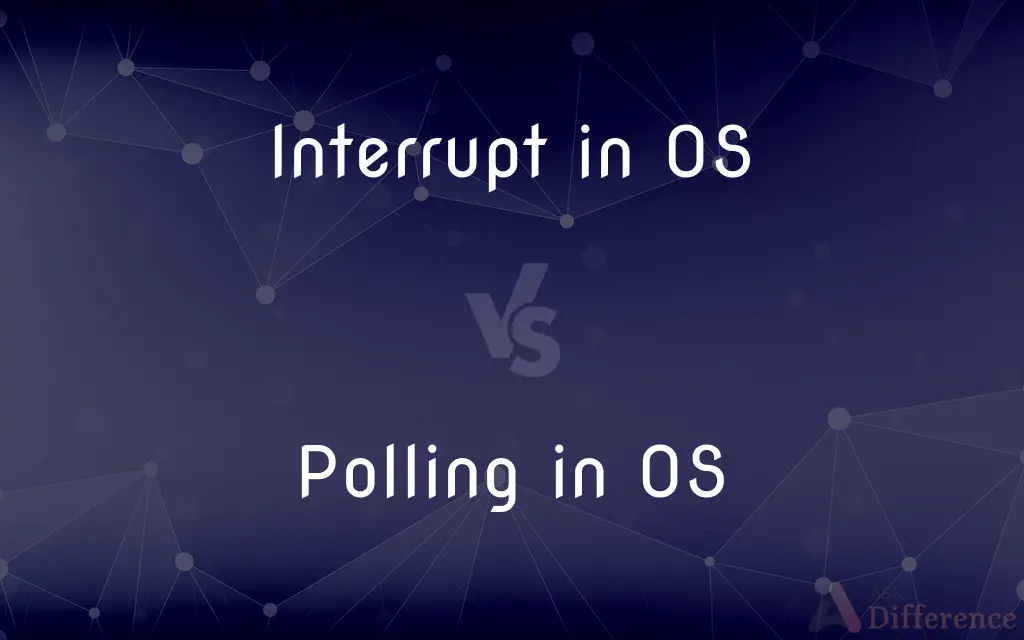Interrupt in OS vs. Polling in OS — What's the Difference?
By Tayyaba Rehman & Urooj Arif — Published on February 3, 2024
Interrupts in an OS are signals to the processor indicating an event needs immediate attention, while polling is the process where the OS continuously checks if an event has occurred.

Difference Between Interrupt in OS and Polling in OS
Table of Contents
ADVERTISEMENT
Key Differences
Interrupts in an Operating System (OS) are signals sent to the processor to indicate that an immediate response is required, typically from hardware or software. This method is efficient as it allows the CPU to address other tasks until an interrupt is received. In contrast, Polling in an OS involves the CPU actively checking the status of an input/output (I/O) device at regular intervals to see if it needs processing. This approach can be less efficient as it requires constant checking, regardless of whether an event has occurred.
In the context of Interrupts in an OS, the process is event-driven; the CPU reacts as soon as an interrupt signal is received, ensuring prompt response to critical events. This mechanism is crucial for handling time-sensitive operations, where delays can be detrimental. On the other hand, Polling in an OS is a proactive approach where the CPU periodically checks for certain conditions or updates. This method can lead to delays in response time, as the CPU might be occupied with other tasks when an event occurs.
Interrupts in an OS provide a way to prioritize tasks, as the processor can interrupt its current task to handle a more urgent task, and then resume the original task. This leads to better resource utilization and system responsiveness. In contrast, Polling in an OS does not inherently prioritize tasks. The CPU might spend unnecessary time checking for events that occur infrequently, thus potentially leading to inefficient use of resources.
The efficiency of Interrupts in an OS is highlighted in high-performance environments where the immediate response is critical. It reduces CPU idle time and maximizes throughput. Conversely, Polling in an OS might be suitable for simpler systems where tasks are less time-sensitive and system resources are limited. In such environments, the simplicity of polling can be advantageous, despite its potential inefficiency.
In summary, Interrupts in an OS are reactive, driven by events and conducive to efficient and responsive systems. They are essential for complex, multitasking environments. Polling in an OS, however, is a simpler, cyclic check that can lead to less efficient use of the CPU, better suited for simpler or less demanding environments.
ADVERTISEMENT
Comparison Chart
Mechanism
Event-driven signal reception.
Continuous cyclic status checking.
CPU Efficiency
High, as it acts on demand.
Lower, due to constant monitoring.
Responsiveness
Immediate response to events.
Delayed, based on check intervals.
Resource Utilization
Optimal, with prioritized tasks.
Potentially inefficient.
Suitability
Ideal for complex, multitasking systems.
Better for simpler systems.
Compare with Definitions
Interrupt in OS
An Interrupt in an OS is a signal to the processor from software or hardware requiring immediate attention.
When a user presses a key, an interrupt signals the OS to process the keystroke.
Polling in OS
Polling in an OS is a method to control devices by periodically checking their status.
The OS polls a sensor to obtain temperature readings at set intervals.
Interrupt in OS
In an OS, interrupts provide a way to respond quickly to external events.
An external USB device triggers an interrupt when connected, prompting the OS to recognize it.
Polling in OS
In an OS, polling is used to monitor and react to hardware status without interrupts.
The OS regularly polls the hard drive to determine if a read or write operation is complete.
Interrupt in OS
Interrupts in an OS are used to handle asynchronous events efficiently.
The OS interrupts its current process to address a sudden disk error signal.
Polling in OS
In an OS, polling involves the CPU actively verifying if an I/O operation is needed.
The OS polls a printer to check if it is ready to receive data.
Interrupt in OS
Interrupts in an OS act as a system's mechanism for handling events as they occur.
A printer sending an interrupt to indicate it has finished printing allows the OS to start a new print job.
Polling in OS
Polling in an OS is a technique where the processor repeatedly checks the status of a device.
The OS constantly polls the mouse to see if its position has changed.
Interrupt in OS
Interrupts in an OS enable preemptive multitasking by interrupting the current CPU task.
An OS interrupts a running application to handle a higher-priority network packet.
Polling in OS
Polling in an OS is a continuous, cyclical process of checking for certain conditions.
An OS polls a network card at regular intervals to detect incoming data.
Common Curiosities
What is an interrupt in an OS?
It's a signal to the processor from either software or hardware indicating immediate attention is required.
How does polling differ from interrupts in an OS?
Polling is a continuous process where the OS checks if an event has occurred, unlike interrupts, which are event-driven.
Are hardware or software interrupts more common?
Both are common, with hardware interrupts typically used for I/O devices and software interrupts for internal events.
Can polling be more efficient than interrupts in any scenario?
Yes, in simpler systems where events occur at predictable intervals, polling can be more efficient.
Do interrupts require specific hardware support?
Yes, most modern processors have built-in support for handling interrupts.
How do interrupts improve multitasking?
By allowing the OS to prioritize and quickly switch between tasks based on urgency.
Can interrupts affect system performance?
Yes, excessive interrupts can lead to overhead and affect performance, but they're generally efficient.
Is polling used in modern operating systems?
Yes, but it's less common than interrupts due to its lower efficiency.
What is interrupt latency?
It's the time taken for the OS to start processing an interrupt after it has occurred.
Why are interrupts important in an OS?
They allow the OS to respond quickly to important events, improving efficiency and responsiveness.
How does an OS differentiate between multiple interrupts?
It uses an interrupt vector to identify and prioritize different interrupt sources.
Does polling always consume CPU resources?
Yes, because the CPU must continuously check for conditions, even if no events have occurred.
Can an OS ignore interrupts?
Yes, an OS can disable interrupts temporarily, but this is generally not advisable.
How does an OS handle simultaneous interrupts?
It prioritizes them based on urgency and may queue less critical interrupts.
Can interrupts and polling be used together in an OS?
Yes, some systems use a combination of both for different tasks.
Share Your Discovery

Previous Comparison
Cross Pollination vs. Self Pollination
Next Comparison
Quotes vs. SayingsAuthor Spotlight
Written by
Tayyaba RehmanTayyaba Rehman is a distinguished writer, currently serving as a primary contributor to askdifference.com. As a researcher in semantics and etymology, Tayyaba's passion for the complexity of languages and their distinctions has found a perfect home on the platform. Tayyaba delves into the intricacies of language, distinguishing between commonly confused words and phrases, thereby providing clarity for readers worldwide.
Co-written by
Urooj ArifUrooj is a skilled content writer at Ask Difference, known for her exceptional ability to simplify complex topics into engaging and informative content. With a passion for research and a flair for clear, concise writing, she consistently delivers articles that resonate with our diverse audience.














































